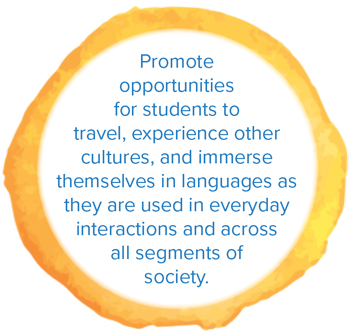Encouraging International Study and Cultural Immersion
A national strategy to broaden access to language education for every student in the United States, as preparation for life and work in a global twenty-first century, must also promote opportunities for students to travel, experience other cultures, and immerse themselves in languages as they are used in everyday interactions and across all segments of society.
In its Heart of the Matter report, the American Academy’s Commission on the Humanities and Social Sciences wrote: “While foreign language study is a crucial step toward a more productive, reciprocal engagement with other cultures and governments, language study alone cannot provide the cultural and historical context in which such exchanges take place.” For this reason, the Commission recommended that “transnational studies, study abroad, and international exchange programs should be expanded as part of undergraduate education.”87 According to the Institute for International Education, 313,000 students received credit for study abroad programs during the 2014–2015 academic year, and several education associations are calling for that number to double by the end of this decade.88

There are now many successful models for study abroad. For example, the Language Flagship model of the National Security Education Program (NSEP-DoD) prepares students at twenty-five American universities to speak, read, and listen in a non-English language at a professional level through intensive training at home and during an overseas capstone year. Similarly, the State Department’s National Security Language Initiative for Youth (NSLI-Y) and Critical Language Scholarship programs support over one thousand students of critical languages in overseas language study annually. Participants in these federal overseas programs come from all socioeconomic backgrounds and include students who have never before left the United States or studied the language in question. These programs prove that most students can successfully learn a language, given proper instruction and adequate support.90 The Departments of State and Defense should expand these successful immersion models, which are creating access for students to languages critical for U.S. national security and global competetiveness.
Many colleges and universities now offer opportunities for international study as well. However, these programs can be expensive—in real dollars, in forfeited income during the period abroad, and in time spent away from home campuses and coursework—and are therefore less accessible to students from disadvantaged backgrounds. Campuses should make every effort to ensure that such students have access and support for overseas coursework—in part by recognizing overseas coursework for either elective or major credit. This recognition would enable students to apply financial aid and student loans to their time abroad, just as they apply it to their home campus studies.91 Unfortunately, even this recognition would not help students who wish to travel during the summer months (a more convenient time for many disadvantaged students) since, under current regulations, federal aid cannot be used to support summer study. The Department of Education should consider restructuring federal financial aid to help low-income undergraduates enjoy study abroad during the summer, as well as the academic year, to obtain language competence in their specific area of study.
But academia and government are not the only potential partners in this effort. Indeed, American businesses may have the most to gain from a workforce that is competent in world languages and effective in international settings. Eighty-eight percent of the executives who responded to the 2014 Coalition for International Education sponsored study reported that international sales will be an equal or greater percentage of their business in the future, and almost two-thirds report a need for international skills at entry and management levels.93 In other words, the United States is rapidly approaching a significant skills gap. Many businesses recognize and address this need by providing language education for their employees through a variety of means, including internal training programs and sponsored coursework. Community colleges have also become important partners by providing effective and affordable language instruction for adults. In addition, through sponsored internships, the private sector and many NGOs have discovered ways to develop a multilingual workforce that can meet their future needs. Some work through programs like Northeastern University’s Global Co-op, which connects students with professional internships abroad, thereby offering language and cultural training as well as valuable work experience.94 Even a quick online search reveals dozens of such opportunities for students interested in exploring professional experiences abroad, including programs with Deloitte, Goldman-Sachs, and the World Bank, as well as U.S. embassies, world governments, and a host of other large and small corporate and nonprofit entities.95 Clearly, it is in the best interests of these organizations, and of U.S business more generally, to recruit and train more talented young people for success in a global economy—and international internships should be a part of any global strategy.
The Critical Language Scholarship Program
According to the Critical Language Scholarship Program, an initiative of the U.S. Department of State, critical languages are non-Western European languages that are important to U.S. national security.89 As of December 2016, the Department of State has identified fourteen critical languages and offers a variety of scholarships and programs for students who wish to study them. They are:
|
|
|
While many federal departments and agencies maintain lists of languages critical to their missions, such as the U.S. Army’s Strategic Languages List, there is no single, unified list of languages considered critical to the federal government.

Jeffrey Wood
Master of Arts Candidate at the Paul H. Nitze School of Advanced International Studies (SAIS) at The Johns Hopkins University; and 2016 Thomas R. Pickering Graduate Foreign Affairs Fellow
Jeffrey Wood was a Washington, D.C., public high school student when he had the opportunity to study abroad in China with D.C.-China Scholars—a program hosted by Americans Promoting Study Abroad—and was featured in the documentary film Beyond the Wall. He has since served as a student ambassador for the 100,000 Strong Foundation and Globalize D.C., and interviewed First Lady Michelle Obama live in China for Discovery Education. An alumnus of the National Security Language Initiative for Youth program, he has been granted numerous other awards, including a Gilman Scholarship, a Boren Undergraduate Scholarship, a UC Berkeley Public Policy and International Affairs Fellowship, and a Fulbright Teaching Fellowship. Wood holds a bachelor’s degree in Chinese language and literature from George Mason University and a certificate in Chinese language and literature from Harbin Institute of Technology.
“Language has given me the ability to expand my understanding of my community, whether that’s in my neighborhood or in a different country. Furthermore, language has given me a direct career path I didn’t think was possible for me to achieve.”92
World-Readiness Standards
A number of teacher associations and learned societies have collaborated to create a series of standards to help design curricula and establish performance outcomes for students as well as for language programs. The primary goal areas of the standards are designed to encourage students achieving the “5 Cs”:
- Communication: Communicate effectively in more than one language in order to function in a variety of situations and for multiple purposes.
- Cultures: Interact with cultural competence and understanding.
- Connections: Connect with other disciplines and acquire information and diverse perspectives in order to use the language to function in academic and career-related situations.
- Comparisons: Develop insight into the nature of language and culture in order to interact with cultural competence.
- Communities: Communicate and interact with cultural competence in order to participate in multilingual communities at home and around the world.
Since 2013, forty states have adopted the World-Readiness Standards as part of their language education programs.96
ENDNOTES
87. American Academy of Arts and Sciences, The Heart of the Matter: The Humanities and Social Sciences for a Vibrant, Competitive, and Secure Nation (Cambridge, Mass.: American Academy of Arts and Sciences, 2013), 58–59.
88. Institute of International Education, “Open Doors,” http://www.iie.org/Research-and-Publications/Open-Doors#.WDyYPPkrKUk; and Institute of International Education, “Generation Study Abroad,” http://www.iie.org/Programs/Generation-Study-Abroad#.WDyYq_krKUk.
89. The Critical Language Scholarship Program, http://clscholarship.org/.
90. Dan E. Davidson, “The Development of L2 Proficiency and Literacy within the Context of the Federally Supported Overseas Language Training Programs for Americans,” To Advanced Proficiency and Beyond: Theory and Methods for Developing Superior Second-Language Ability, ed. Tony Brown and Jennifer Brown (Washington, D.C.: Georgetown University Press, 2015), 117–150.
91. Federal student aid can be used for study abroad (short-term programs while remaining enrolled at a U.S. home campus) and for direct enrollment at a foreign higher education institution (HEI) if the foreign HEI has been approved for federal student aid participation. See Federal Student Aid, U.S. Department of Education, “International Schools,” https://studentaid.ed.gov/sa/prepare-for-college/choosing-schools/types/international (accessed January 19, 2017).
92. Email exchange with the Commission on Language Learning, November 2016.
93. Daniel, Xie and Kedia, “2014 U.S. Business Needs for Employees with International Expertise.”
94. Northeastern University, Global Experience Office, “Global Co-Op,” http://www.northeastern.edu/geo/globalcoop/.
95. Go Overseas, “10 Paid Internships Abroad in Summer 2016 & 2017,” https://www.gooverseas.com/blog/10-paid-internships-abroad-in-summer.
96. American Council on the Teaching of Foreign Languages, “World-Readiness Standards for Learning Languages,” https://www.actfl.org/publications/all/world-readiness-standards-learning-languages.